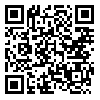دوره 13، شماره 1 - ( 1-1404 )
جلد 13 شماره 1 صفحات 104-88 |
برگشت به فهرست نسخه ها
Download citation:
BibTeX | RIS | EndNote | Medlars | ProCite | Reference Manager | RefWorks
Send citation to:



BibTeX | RIS | EndNote | Medlars | ProCite | Reference Manager | RefWorks
Send citation to:
Gooran S, Mirmoghtadaie Z, Khoshgoftar Z, Keshavarz M. Identifying and prioritizing educational needs in e-learning students: a mixed-methods study. jmsthums 2025; 13 (1) :88-104
URL: http://jms.thums.ac.ir/article-1-1356-fa.html
URL: http://jms.thums.ac.ir/article-1-1356-fa.html
گوران سحر، میرمقتدایی زهره السادات، خوش گفتار زهره، کشاورز محسن. شناسایی و اولویتبندی نیازهای آموزشی دانشجویان در حوزه یادگیری الکترونیکی: یک مطالعه ترکیبی. مجله دانشگاه علوم پزشکی تربت حیدریه. 1404; 13 (1) :88-104
1- گروه یادگیری الکترونیکی در علوم پزشکی، دانشکده آموزش پزشکی و فناوریهای نوین، دانشگاه علوم پزشکی شهید بهشتی، تهران، ایران
2- گروه آموزش پزشکی، دانشکده آموزش پزشکی و فناوریهای نوین، دانشگاه علوم پزشکی شهید بهشتی، تهران، ایران
3- گروه یادگیری الکترونیکی در علوم پزشکی، دانشکده پیراپزشکی، دانشگاه علوم پزشکی تربت حیدریه، تربت حیدریه، ایران
2- گروه آموزش پزشکی، دانشکده آموزش پزشکی و فناوریهای نوین، دانشگاه علوم پزشکی شهید بهشتی، تهران، ایران
3- گروه یادگیری الکترونیکی در علوم پزشکی، دانشکده پیراپزشکی، دانشگاه علوم پزشکی تربت حیدریه، تربت حیدریه، ایران
چکیده: (814 مشاهده)
زمینه و هدف: ارتقای کیفیت آموزش پزشکی از طریق فناوریهای نوین نیازمند شناسایی دقیق نیازهای آموزشی دانشجویان میباشد. این پژوهش با شناسایی دقیق نیازهای دانشجویان در زمینه آموزش مجازی، درصدد کمک به طراحی برنامههای آموزشی مؤثرتر و بهبود کیفیت آموزش مجازی میباشد.
روش ها: مطالعه حاضر از نوع ترکیبی و به روش تحلیل محتوا در بخش کیفی و مطالعه توصیفی در بخش کمی در بازه زمانی 1401-1399 در دانشگاه علوم پزشکی شهید بهشتی تهران انجام شد. در بخش کیفی نمونهگیری مبتنی بر هدف آغاز و با روش نمونهگیری گلوله برفی تا رسیدن به اشباع دادهها ادامه یافت. دادهها با استفاده از مصاحبه نیمهساختاریافته جمعآوری و بارویکرد دیکلمن تحلیل شدند. در بخش کمی پرسشنامه شامل ۵۳ سوال در رابطه با نیازهای آموزشی توسط 330 دانشجوی زیرمجموعه علوم پزشکی تکمیل و تحلیل دادهها و سنجش اولویت نیازهای آموزشی در دو سطح توصیفی و استنباطی با استفاده از نرمافزار SPSS انجام شد.
نتایج: تحلیل مصاحبههای انجامشده، به استخراج ۵۳ مفهوم اولیه و نهایتاً ۶ مقوله کلی منجر شد. این مقولهها شامل: مشکلات زیرساختی، نظارت و پشتیبانی آموزشی، محتوای آموزشی، ارزشیابی، تعامل آموزشی، و چالشها و فرصتهای آموزش مجازی بودند که بهعنوان نیازهای درک شده دانشجویان در حوزه یادگیری الکترونیکی شناسایی شدند. بر اساس نتایج اولویتبندی نیازهای آموزشی دانشجویان، حوزههای چالشهای آموزشی و فرصتها با میانگین رتبه 6، نظارت و پشتیبانی با 4/91، زیرساخت با 3/62، ارزشیابی با 3/29، مشکلات مربوط به محتوا با 1/92 و تعامل با 1/26 به ترتیب در اولویتهای اصلی قرار گرفتهاند.
نتیجه گیری: توجه به زیرساختها، نظارت، کیفیت تدریس، ارزشیابی و تعامل، برای نهادهای آموزشی ضروری است تا کیفیت آموزش را ارتقا دهند. پردازش نیازهای دانشجویان میتواند به افزایش رضایتمندی و بهبود کیفیت آموزش الکترونیکی کمک کند.
روش ها: مطالعه حاضر از نوع ترکیبی و به روش تحلیل محتوا در بخش کیفی و مطالعه توصیفی در بخش کمی در بازه زمانی 1401-1399 در دانشگاه علوم پزشکی شهید بهشتی تهران انجام شد. در بخش کیفی نمونهگیری مبتنی بر هدف آغاز و با روش نمونهگیری گلوله برفی تا رسیدن به اشباع دادهها ادامه یافت. دادهها با استفاده از مصاحبه نیمهساختاریافته جمعآوری و بارویکرد دیکلمن تحلیل شدند. در بخش کمی پرسشنامه شامل ۵۳ سوال در رابطه با نیازهای آموزشی توسط 330 دانشجوی زیرمجموعه علوم پزشکی تکمیل و تحلیل دادهها و سنجش اولویت نیازهای آموزشی در دو سطح توصیفی و استنباطی با استفاده از نرمافزار SPSS انجام شد.
نتایج: تحلیل مصاحبههای انجامشده، به استخراج ۵۳ مفهوم اولیه و نهایتاً ۶ مقوله کلی منجر شد. این مقولهها شامل: مشکلات زیرساختی، نظارت و پشتیبانی آموزشی، محتوای آموزشی، ارزشیابی، تعامل آموزشی، و چالشها و فرصتهای آموزش مجازی بودند که بهعنوان نیازهای درک شده دانشجویان در حوزه یادگیری الکترونیکی شناسایی شدند. بر اساس نتایج اولویتبندی نیازهای آموزشی دانشجویان، حوزههای چالشهای آموزشی و فرصتها با میانگین رتبه 6، نظارت و پشتیبانی با 4/91، زیرساخت با 3/62، ارزشیابی با 3/29، مشکلات مربوط به محتوا با 1/92 و تعامل با 1/26 به ترتیب در اولویتهای اصلی قرار گرفتهاند.
نتیجه گیری: توجه به زیرساختها، نظارت، کیفیت تدریس، ارزشیابی و تعامل، برای نهادهای آموزشی ضروری است تا کیفیت آموزش را ارتقا دهند. پردازش نیازهای دانشجویان میتواند به افزایش رضایتمندی و بهبود کیفیت آموزش الکترونیکی کمک کند.
فهرست منابع
1. Jalalabadi B, Mohaghegzadeh F. The effect of effective factors on the quality of education of virtual education programs in the era of Corona. Scientific journal of new research approaches in management and accounting.2022;22(6):1180-1196.
2. Ebrahimi M, Alishah F, zamanipour F. Identify and analyze the opportunities and challenges of students' virtual education. New Educational Approaches 2021;16(2):15-32.
3. Chinazzi M, Davis JT, Ajelli M, Gioannini C, Litvinova M, Merler S, et al. The effect of travel restrictions on the spread of the 2019 novel coronavirus (COVID-19) outbreak. Science. 2020;368(6489):395-400. [DOI:10.1126/science.aba9757]
4. Daniel SJ. Education and the COVID-19 pandemic. Prospects. 2020;49(1):91-6. [DOI:10.1007/s11125-020-09464-3]
5. Pokhrel S, Chhetri R. A literature review on impact of COVID-19 pandemic on teaching and learning. Higher education for the future. 2021.133-41(1)8 [DOI:10.1177/2347631120983481]
6. Paudel P. Online education: Benefits, challenges and strategies during and after COVID-19 in higher education. International Journal on Studies in Education (IJonSE). 2021;3(2). [DOI:10.46328/ijonse.32]
7. Adedoyin OB, Soykan E. Covid-19 pandemic and online learning: the challenges and opportunities. Interactive Learning Environments. 2023;31(2):863-75. [DOI:10.1080/10494820.2020.1813180]
8. Mosalanezhad L, Atashpoor S, Kalani N. What do medical students want to learn in the Corona Crisis Curriculum? Expressing Students' Expectations and Strategies. Education and Ethics In Nursing ISSN: 2322-5300. 2021;10(1-2):4-11.
9. Jhajj S, Kaur P, Jhajj P, Ramadan A, Jain P, Upadhyay S, et al. Impact of Covid-19 on medical students around the globe. Journal of community hospital internal medicine perspectives. 2022;12(4):1. [DOI:10.55729/2000-9666.1082]
10. Mohammadi A. The Role of Virtual Education in the Academic Progress of Students. The journal "Psychology and Educational Sciences in the Third Millennium.2023 ;22(7):45-52"
11. Almusaed A, Almssad A, Yitmen I, Homod RZ. Enhancing student engagement: Harnessing "AIED"'s power in hybrid education-A review analysis. Education Sciences. 2023;13(7):632. [DOI:10.3390/educsci13070632]
12. Alrajaby S. Perceptions of Medical Students on the Transition to and Impact of Online Learning During the COVID-19 Pandemic: A Qualitative Study. Cureus. 2024;16(5):e59872. [DOI:10.7759/cureus.59872]
13. Al-Iede M, Albaramki J, Alsoudi A, Al-Ani R, Al-Akhras FA, Al Najada R, et al. The perceptions of medical students of online teaching during the COVID-19 pandemic: a national survey from Jordan. J Med Life. 2024;17(4):412-7. [DOI:10.25122/jml-2023-0116]
14. Rajab MH, Gazal AM, Alkattan K. Challenges to online medical education during the COVID-19 pandemic. Cureus. 2020;12(7). [DOI:10.7759/cureus.8966]
15. Nouraey P, Al-Badi A. Challenges and problems of e-learning: A conceptual framework. Electronic Journal of e-Learning. 2023;21(3):188-99. [DOI:10.34190/ejel.21.3.2677]
16. Mosia M. Online or Face-to-Face: A Data-Analytics Approach to Understanding First-Year Students' Learning Preferences and Academic Achievements. Studies in Learning and Teaching. 2024;5(1):219-27. [DOI:10.46627/silet.v5i1.366]
17. Zahed Babelan A, Mehravar S, Kazami S, Javidpour M. Evaluating the Quality of Electronic Education in the Higher Education System Using the HELAM Evaluation Model. gums-rme. 2023;15(1):13-21. [DOI:10.32592/rmegums.15.1.13]
18. Al Zahrani EM, Al Naam YA, AlRabeeah SM, Aldossary DN, Al-Jamea LH, Woodman A, et al. E-Learning experience of the medical profession's college students during COVID-19 pandemic in Saudi Arabia. BMC medical education. 2021;21:1-11. [DOI:10.1186/s12909-021-02860-z]
19. Zarei A, Javadipour M. Problems of E-learning in the University of Tehran due to the Spread of Coronavirus. Journal of Management and Planning In Educational System. 2021.313-42:(2)14 [DOI:10.52547/MPES.14.2.313]
20. Moosavi S, Gholamnejad H, Hassan-Shiri F, Fatemeh G-K, Raoufi S. Challenges of Virtual education During the Pandemic of COVID-19: A Qualitative Research. Iran Journal of Nursing (IJN). 2022;35(135):94-105. [DOI:10.32598/ijn.35.135.3030]
21. Means BA, Julie%Anull Ed.%BJournal Name: Online Learning, 25 JV, 1 JI. Teaching and Learning in the Time of COVID: The Student Perspective. Journal Name: Online Learning; Journal Volume: 25; Journal Issue: 1. 2021:Medium: X. [DOI:10.24059/olj.v25i1.2496]
22. Mahyoob M. Challenges of e-Learning during the COVID-19 Pandemic Experienced by EFL Learners. Arab World English Journal (AWEJ). 2020;11(4):351-62 [DOI:10.24093/awej/vol11no4.23]
23. Sadati L, Nouri Z, Hajfiroozabadi M, Abjar R. Faculty Members' Experiences About Virtual Education Opportunities and Challenges During The Covid-19: A Qualitative Study. edujournal. 2021;14(42):1-10. [DOI:10.52547/edcj.14.42.1]
24. Fazli F, Valipour Khajegheyasi R, Fazli H, Molania T. Quality of Virtual Learning during COVID-19 Pandemic from the Perspective of Dental Students in Mazandaran University of Medical Sciences. J-Mazand-Univ-Med-Sci. 2022;32(209):134-45.
25. Nuuyoma V, Lauliso SS, Chihururu L. Perspectives of nursing students on challenges of e-learning during early stages of the COVID-19 pandemic. curationis. 2023;46(1):2358. [DOI:10.4102/curationis.v46i1.2358]
26. Yadollāhi S, Tavakoli E, Poorsālehi N, Āzartāsh F. Online teaching problems during COVID 19 pandemic from teachers and parents' viewpoints and suggesting practical solutions. Educational innovations.2021;20(3):45-117
27. Azizi Y, Sadeghi A, Abdullahi A. Identifying and prioritizing the needs of students in the curriculum elements of general courses. Curriculum and educational planning researches. 2021;12(1):1-18.
28. Rajab MH, Gazal AM, Alkattan K. Challenges to Online Medical Education During the COVID-19 Pandemic. Cureus. 2020;12(7):e8966. [DOI:10.7759/cureus.8966]
29. Ameri H, Mahami-Oskouei M, Sharafi S, Saadatjoo S, Miri M, Arab-Zozani M. Investigating the strengths and weaknesses of online education during COVID-19 pandemic from the perspective of professors and students of medical universities and proposing solutions: A qualitative study. Biochem Mol Biol Educ. 2023;51(1):94-102. [DOI:10.1002/bmb.21691]
30. Taghizadeh S, Haji J, Mohammadimehr M. A Comparative Study of the Challenges and Opportunities of Higher Education in the Corona Pandemic in Iran and around the World. Nurse and Physician within War. 2020;8(27):47-57. [DOI:10.29252/npwjm.8.27.47]
ارسال پیام به نویسنده مسئول
| بازنشر اطلاعات | |
 | این مقاله تحت شرایط Creative Commons Attribution-NonCommercial 4.0 International License قابل بازنشر است. |







